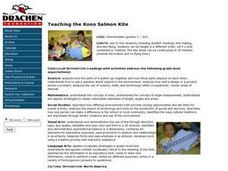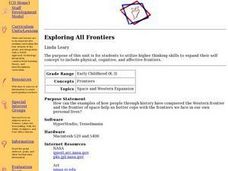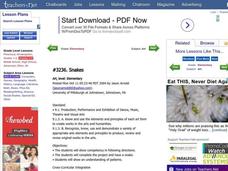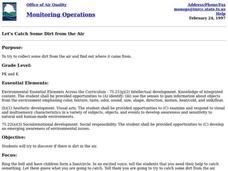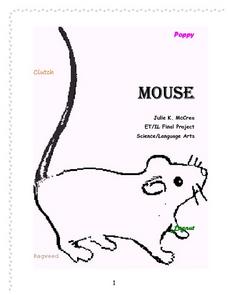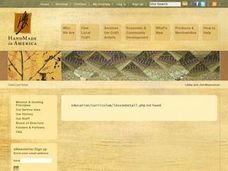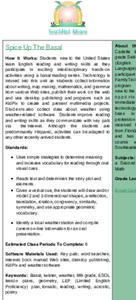Curated OER
Introducing Biodiversity
Students investigate biodiversity by creating reports with their classmates. In this ecosystem lesson, students utilize the Internet to research the different types of life in our environment and different locations around the world....
Curated OER
All About Trees
Second graders examine the artwork of Robert Harris and discuss how trees are an important part of their lives. In groups, they discover how people's use of the environment has changed over time and describe the climate and vegetation...
Curated OER
Dancin' to the Times
Fifth graders work in groups in order to research a specific music era or dance style to share with the class. They have studied different music styles that are included in the lesson plan and now they have the choice to research one. ...
Curated OER
Mouthpart Madness
Learners explore the basic biology of a pest. They identify the four major kinds of insect mouthparts and explain how they work. Students examine the specific mouthparts and how they can limit food resources and in what environment an...
Curated OER
Teaching the Kono Salmon Kite
Students complete several student readings involving kite making and kite flying. They analyze how the parts of a system go together and how these parts depend on each other. They comprehend how different environments both provide...
Curated OER
Teaching the Bell Tetrahedral Kite
Students complete readings on kite making and kite flying. They analyze how the parts of a system interconnect and influence each other. Students identifies and uses color and form in a 3D artwork.
Curated OER
Learning About Guatemala Through Its Kites
Students are introduced to Guatemala and to the tradition of giant kites. They decorate the kite sail and construct the kite. Students identifies possible causal factors contributing to given historical events.
Curated OER
Inhale the Colour of Life
Students view examples of portraits noting how the colors used make them feel. Using the same portrait, they redo them using different colors and then compare and contrast the first painting and second one in regards to how it makes...
Curated OER
Playing the Cardboard Dulcimer
Second graders create cardboard dulcimers. They discover that sound is produced by vibrating strings and analyze the pitch produced by changing the sizes and length of the strings of the instrument. They also discuss the history of the...
Curated OER
Exploring All Frontiers
Young scholars utilize higher thinking skills to expand their self concept to include physical, cognitive, and affective frontiers. The teacher create activities which allow students to use raw data and primary sources, as well as...
Curated OER
Snakes
Students follow directions to make a snake out of patterns. They research a specific snake and present it to the class in a group. They listen to a presentation about the King Cobra snake prepared by the teacher.
Curated OER
Changing Images of Childhood in America: Colonial, Federal and Modern England
Students compare and contrast maps of New Haven, Connecticut from today and the past. After taking a field trip, they draw sketches of the types of architecture and discuss how the buildings have changed over time. They read journal...
Curated OER
Let's Catch Some Dirt From the Air
Learners investigate the dirt in the air. In this air quality lesson, students use aluminum foil and petroleum jelly to discover if there is dirt in the air. Learners discuss results.
Curated OER
The Role of the Museum
Young scholars identify the role of the museum as a cultural resource in the community. They use primary and secondary sources to evaluate institutional, and media influences on people and society in both historical and contemporary...
Curated OER
Mouse
First graders are exposed to a variety of texts that deal with mice. The use of the library is recommended to saturate the classroom with available books. Young students work in groups with the help of the teacher to define traits and...
Curated OER
A Monument to Value
Students build a monument to represent trustworthiness. In this trustworthiness lesson plan, students discuss traits related to trustworthiness, suggest images that represent trustworthiness, and build a monument with those images.
Curated OER
The More Things Change...
Young scholars participate in a mock town hall meeting after researching issues relating to fishing rights. After reading The Lorax, they discuss the importance of conserving natural resources. In partners, they write a story of their...
Curated OER
Digital Photography and Landforms
Fifth graders create a picture book of local landforms using digital cameras. They also illustrate two vocabulary terms by hand and locate pictures of other geography vocabulary terms in magazines. Students take picture-taking field...
Curated OER
Rainforest Plants and Animals -- Where Are They?
Students identify the plant and animals in the rainforest. Using the internet, they research how these plants and animals adapt to survive in this type of environment. In groups, they critique artwork and discuss how they were depicted.
Curated OER
Spice Up the Basal
Fifth graders study English reading and writing skills as they participate in exciting interdisciplinary hands-on activities using a basal reading series.
Curated OER
Farms And Cities
Students differentiate the differences of living on a farm or in a city. They do this with the use of coloring pictures and have group discussion about each picture to identify characteristics and identify where the picture is from. The...
Curated OER
Celebrate Your Culture
Third graders share some special occasions/events observed by their families/neighborhoods, and special activities/traditions connected with the event. They identify their own culture's customs and those of others.
Curated OER
Jazz in America
Eleventh graders explore Jazz in America. They examine greats in Jazz, such as Duke Ellington. They are also to discuss the cultural implications of the music itself.
Curated OER
Navajo Weaving
Learners explore the Navajo culture. In this Navajo Indians lesson, students gain information about their weaving and dancing. Learners note the patterns in the weaving. Students create a dance that corresponds with the patterns they see...






